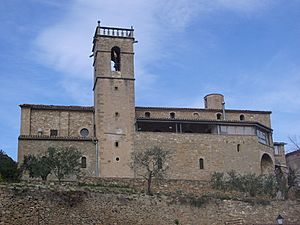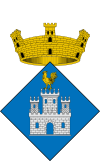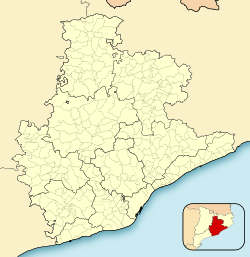Castellgalí facts for kids
Quick facts for kids
Castellgalí
|
|||
|---|---|---|---|
|
Municipality
|
|||
 |
|||
|
|||
| Country | |||
| Community | |||
| Province | Barcelona | ||
| Comarca | Bages | ||
| Area | |||
| • Total | 17.2 km2 (6.6 sq mi) | ||
| Elevation | 266 m (873 ft) | ||
| Population
(2018)
|
|||
| • Total | 2,053 | ||
| • Density | 119.4/km2 (309.1/sq mi) | ||
| Demonym(s) | Castellgalí, castellgalina | ||
Castellgalí (pronounced kas-tel-ga-LEE) is a small town, also called a municipality, in Catalonia, Spain. It is located in the south of the Bages region. This special place is where two rivers, the Cardener and Llobregat, meet. Castellgalí is home to very old historical sites. These include the Boades archaeological site and the Torre del Breny. They are considered important ancient Greek sites in Catalonia.
Contents
Discovering Castellgalí's Past
Ancient Iberian Settlements
The first signs of people living in Castellgalí were found at a place called Boades. This was an Iberian settlement. People lived here between the 6th and 1st centuries BC. Another Iberian settlement was at Puig del Castel. It existed from the 4th to 1st centuries BC.
The Boades settlement was located between the Llobregat and Cardener rivers. This made the land very good for farming. The people grew lots of cereals, olive trees, and vineyards. They even had extra food to export to other places. The area was also great for hunting.
Roman Influence and Monuments
When the Romans arrived, the Iberian settlement at Puig del Castell slowly disappeared. However, Boades became a Roman village. It was an important trading center. This was because it was on the main trade routes along the Llobregat and Cardener rivers.
The Romans also built impressive funerary monuments here. These include the Torre del Breny and the Roman tomb of Boades. The Torre del Breny was a large Roman tomb shaped like a temple. Part of it was taken apart in 1870. Its stones were used to build a nearby dam.
The Roman tomb at Boades is about 100 meters south of the Roman village. It was built in the 3rd century. This tomb is a great example of Roman funerary practices in Catalonia. Old items found during digs in this area are now kept at the Manresa regional museum.
Medieval Times and the Castle
The town of Castellgalí began around its castle. A document from the year 867 mentions the Castelo de Galindo. This is where the town's name comes from. We don't know much about this castle, which is now in ruins.
The first rulers of the castle were the Galí family. In 1178, King Alfonso II of Aragon bought the castle. He then gave it to his vassals, called castlans. These castlans took the name Castellgalí as their own.
Later, the Black Death affected Castellgalí. Many farms became empty, and the last castlans died. In 1350, King Peter the Ceremonious sold the castle to Bernat Torres. The castle changed hands a few more times. It was sold to Luis de Rajadell in 1413.
During the Catalan Civil War (1462-1472), the castle's owner, Manel de Rajadell, left the village. He supported King Juan II. It is believed the castle was destroyed during this war.
Modern Growth and Changes
In the 18th century, growing grapevines became very popular. This helped Castellgalí's population grow. The old part of the town got its current look during this time. You can still see the years carved on the lintels of old houses. Some even show pictures of services offered, like a horseshoe for a blacksmith.
The old town grew around the main road, an inn, and the church. In 1812, feudal duties were ended. The last noble families to own land here were the Amigants and then the Despujol family.
The 19th and 20th Centuries
The 19th century was a busy time for Castellgalí. It saw the war of independence and three Carlist Wars. But it was also a time of progress. A new cemetery was built in 1892. The church was made bigger in 1897. The railway arrived in 1859, and a telegraph antenna in 1887.
Castellgalí was seen as a safe place during these conflicts. It was a refuge for troops. The first factories started here in the late 1800s. These factories, like the Barrera textile mill (1816) and Carbons Elèctrics (1898), shaped the town's future.
The growth of factories meant more people moved to Castellgalí. The population grew until the late 1970s. The Spanish Civil War (1936-1939) caused damage. Many church items were lost, like 17th-century altarpieces. Figures of saints were also destroyed.
After a dip in population, it started growing again in the mid-1990s. A new residential area called Mas Planoi was built. It continues to expand today.
Places to Explore in Castellgalí
Where Rivers Meet
The Cardener and Llobregat rivers join together here. This area has lots of riverside plants, especially poplars. It's a peaceful spot, perfect for bird-watching. You can see different birds during migration seasons.
In colder months, you might spot shoveler ducks or grunting ducks. The great cormorant is easier to see. Grey herons and kingfishers live here all year round.
Boades Archaeological Site and Torre del Breny
The Torre del Breny is also known as the Tower of the Demons. It was partly changed in the Middle Ages. A farmhouse was built next to it, and new openings were made. This tower is a tomb shaped like a tower. Its base is still standing today.
The tower is very strong. It is built with large, well-cut stones. Inside, there are two rectangular rooms with curved ceilings. Old drawings show what it looked like originally. It had a base that was about 10 by 10.5 meters and 3 meters high.
L'Excedra is a special chamber in the Boades area. It has a curved, semicircular shape. It is built with natural stone blocks. It has a large window with a round arch. This is a Roman building from the 3rd century AD. It shows how important and grand Roman villages were.
Roman Sepulchre: Also in Boades, there is a small square Roman building. It dates from the 3rd or 4th century AD. It has strong walls and a well-made base. It used to have two floors. Today, it has been rebuilt a lot.
Casa Amigant: Castellgalí Museum
This old manor house is next to the church of Sant Miquel. Its history goes back to the late 1600s. The Amigant family, who were lords of Castellgalí, bought the castle in 1673. They owned the area until feudal lordships were ended in 1812.
In 1684, Josep d'Amigant i Ferrer turned this building into a manor house. He put his family's coat of arms on the front. He also helped the Christian faith. He brought relics of the town's patron saints.
The building now belongs to the Castellgalí Town Council. The museum opened in 1991. It also houses the Youth Information Point. It has exhibition rooms and a computer room. On the front of the house, you can see the year 1684 carved. There is also the Amigant family coat of arms.
Castle and Chapel of Santa Maria
The castle once controlled the area that is now Castellgalí. Pieces of Iberian pottery found here show that people lived on this hilltop even before the castle. The castle is first mentioned in documents from 924. It was built by someone named Galí.
The castle was sold to King Alfonso I in 1178. He then gave it to a family who took the surname Castellgalí. Later, King Peter III sold some rights over the castle. The castle changed hands many times after that.
The Amigant family bought the castle in 1563. They owned it until 1812. By 1473, the castle was already in bad shape. It was not lived in and was damaged after a war. The Amigants decided to use Casa Amigant in the village as their main house instead of fixing the castle.
A small church, the chapel of Santa Maria, was inside the castle grounds. It is mentioned in 1292. It might have been the local parish church or just the castle's chapel. In 1970, people from the village dug up the castle hill and found the church's remains.
Church of Saint Michael of Castellgalí
This church is in the center of the old town. It has two main sections, or aisles. The central one is wider than the side one. The ceilings are made to look like old pointed arches. There are six decorative stones where the ceiling arches meet.
Four pillars separate the central part from the side part. Rounded windows and a round window on the front help light up the church. The main door faces west. It is in the Neo-Gothic style with pointed arches.
The church has a square bell tower. The front of the church is plastered. The lower part is made of well-cut stone. Inside the side section, there is a medallion. It shows the two patron saints, Saint Honest and Saint Repelion.
Fun Local Festivals
Saint Margaret's Meeting (Aplec)
This festival happens on the third weekend of October. It was brought back in 1992. Before the Civil War, people used to walk up to the hermitage (a small chapel). They would stop at the Creu del Pla. A church service was held, and people sang. Everyone brought their lunch to eat around the hermitage.
Since the festival started again, the area has been improved. The chapel's inside was cleaned. In 1993, a sculptor made a new statue of Santa Margarida. Steps were added to make it easier to get there.
Today, the Aplec involves a 30-minute walk to the hermitage. People share an aperitif (small snacks). There's a meal, a church service, and music. There are also fun activities for children, like sack races.
Elders' Festival
This festival is held on the third weekend in February. It starts with a morning church service. The traditional Castellgalí dwarfs are brought out to dance. These are considered the biggest dwarfs in Catalonia! Their names are Margarida (the adult female), Quela (the smaller female), and Repel-lió (the male).
In Plaça Cadevall, there's a popular cake competition. People can win prizes. Finally, all the older people in the village enjoy a special meal together.
"Panellet" (Bread Roll) Festival
This festival has been celebrated since 1968. It takes place on the first weekend in May. It used to be on May 8th. This date marks the start of summer farming work.
The main event is on Sunday at church. The panellets (bread rolls) are blessed. These are not the sweet panellets eaten during Castanyada. These are special bread rolls. They are given out after the church service.
After the service, the Panellet dance is performed. Tradition says that if you keep a blessed panellet at home, you will always have bread. The festival weekend now includes many activities. There's a "Ruta del Zorro," a food market, sports, and workshops. There are also art shows and games for kids.
Main Festival (Festa Major)
This big festival is held on the first weekend of August. The following Monday is a local holiday. Highlights include a popular botifarrada (grilled sausages) with a show. There are also events for young people and dances. Fun activities for children are organized throughout the town.
Originally, this festival honored the patron saints Sant Honest and Sant Repel·lió. It was held on the first weekend in September. Farmers would pray to these saints to protect their crops.
Economy and Population
The average income in Castellgalí was about 28,864 euros in 2019. This places it among towns with more than 1,000 people in Spain. The average income grew by about 1,188 euros (4.29%) from 2018 to 2019.
The population of Castellgalí has changed a lot over the years. After a drop in the late 1800s, it grew until 1960. Then it slowly went down until 1996. Since then, the population has grown steadily. In 1986, there were 705 people. By 2021, there were 2,119. Today, the number is close to 2,300 residents.
Most farming in Castellgalí depends on rain. The main crops are barley, vegetables, and olives. Livestock farming is also important. Farmers raise pigs, chickens, and cows.
In terms of industry, the first company started in 1898. It was an electric coal factory. This company was the first of its kind in Spain. It even sold electric coals for lighting in Glasgow and Melbourne in 1914. The factory's products were called Claret.
The original company no longer exists. But other industries have taken its place. The factory still has six chimneys. It is the only factory in Spain with so many. There is also a quarry company in the town.
Castellgalí has six industrial areas. These include Els Torrents, La Fàbrica, and Els Carbures. The newest one, Pla del Camí, was built in the late 1990s.
| 1900 | 1930 | 1950 | 1970 | 1986 | 2007 |
|---|---|---|---|---|---|
| 775 | 1009 | 887 | 1033 | 705 | 1611 |
See also
 In Spanish: Castellgalí para niños
In Spanish: Castellgalí para niños





